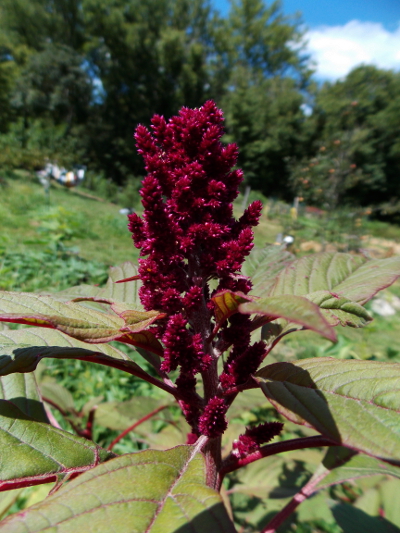
Amaranth for leafy greens
 Two readers left comments last week on old
posts about amaranth
we grew for grain a few years ago, which reminded me I wanted to share my
experience with growing amaranth for greens. Generally,
you'll choose either a greens or a grain variety when you plant
(although, presumably, both are multi-purpose to a certain
extent). Our first experiment, when growing grain amaranth,
was with Manna de Montana, which I had trouble getting to
germinate but which then grew into huge plants and produced lots
of seeds. (We didn't even sample the leaves because I didn't
know they were edible at the time.) Joe (a reader) kindly
sent us some seeds for Mayo Indian amaranth this year, mentioning
that he likes the variety for greens, so we decided to give it a
shot.
Two readers left comments last week on old
posts about amaranth
we grew for grain a few years ago, which reminded me I wanted to share my
experience with growing amaranth for greens. Generally,
you'll choose either a greens or a grain variety when you plant
(although, presumably, both are multi-purpose to a certain
extent). Our first experiment, when growing grain amaranth,
was with Manna de Montana, which I had trouble getting to
germinate but which then grew into huge plants and produced lots
of seeds. (We didn't even sample the leaves because I didn't
know they were edible at the time.) Joe (a reader) kindly
sent us some seeds for Mayo Indian amaranth this year, mentioning
that he likes the variety for greens, so we decided to give it a
shot.
I planted the
amaranth late (in mid-July), but it still jumped right up and grew
like crazy. The plants have a reddish tinge to the leaves
and produce red seed heads so pretty that my mom put some in a
vase as an ornamental after coming to visit. I wasn't as
keen on the taste, though. The leaves were edible, but when
raw they had a mucilaginous texture like sassafras leaves
(interesting in small amounts, but you wouldn't want to eat a lot
of them), and cooked the flavor didn't stand up to that of our
summer favorite, Swiss chard.
On the other hand,
after a search of the internet, I discovered that Mayo Indian
amaranth is usually grown for the grain, so I guess I've yet to
try a true greens amaranth. Anyone have a favorite variety
to recommend?
Want more in-depth information? Browse through our books.
Or explore more posts by date or by subject.
About us: Anna Hess and Mark Hamilton spent over a decade living self-sufficiently in the mountains of Virginia before moving north to start over from scratch in the foothills of Ohio. They've experimented with permaculture, no-till gardening, trailersteading, home-based microbusinesses and much more, writing about their adventures in both blogs and books.
Want to be notified when new comments are posted on this page? Click on the RSS button after you add a comment to subscribe to the comment feed, or simply check the box beside "email replies to me" while writing your comment.

That has been our experience as well, you might try Orach for a summer green go along with chard. It's my summer spinach substitute because it loves the heat, and it is beautiful to boot. We love this plant! http://www.wildgardenseed.com/index.php?cPath=47&osCsid=f10c10f43192a023a1e51a25af3d32ce
The ones that I think produce the best greens are the wild varieties. Basically the ones that get plain, boring green flower spikes. I found one years ago at a house I was renting, it has large fat rounded leaves. Ive carried the seeds with me ever since. They taste just like young chard to me.